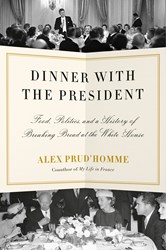Dinner with the President: Food, Politics, and a History of Breaking Bread at the White House
February 02, 2023
Alex Prud’homme’s Dinner with the President shines in revealing how the comforts of a good meal can help us tap back into our humanity and reconnect with one another during an ideologically divided and socially distanced era.

Dinner with the President: Food, Politics, and a History of Breaking Bread at the White House by Alex Prud’homme, Knopf
I got engaged a few months ago, and as I write this review, my fiancé and I are deep in the weeds of planning our wedding. The prospect of marriage is one I’m very excited about; the idea of a wedding, on the other hand, has mostly confounded me. Influenced by Priya Parker’s The Art of Gathering, I’ve found myself circling the same question for months: what purpose does a wedding truly serve?
To me, the end goal of a wedding is not, in fact, the marriage itself. If marriage is a promise to set off on a shared lifelong journey together, I would argue that my fiancé and I started down that path well before the moment we agreed to get married. If marriage is simply a legal agreement, we could go square away the paperwork at the county courthouse and be officially married by this time next week. The aspects that make up most weddings—from the people we gather, to the meals we serve, to the traditions we choose to uphold or eschew—hint at some deeper purpose that goes beyond just the union of the newlyweds.
Unexpectedly, I've gained more clarity around this question not through any bridal magazine, but in the history of meals served at the White House, as chronicled by food historian Alex Prud’homme in the book Dinner with the President.
Prud’homme, whose great-aunt was the famed Julia Child, found himself curious about the significance of presidential state dinners after compiling research on Child’s involvement in the first-ever televised state dinner between President Lyndon B. Johnson and Japanese prime minister Eisaku Sato. As Prud’homme notes, Child “recognized the practical and symbolic importance of the meals served [at the White House], and felt it was her patriotic duty to publicize them.” This book serves as a continuation of that legacy, as Prud’homme unearths some of the most interesting food stories in the history of the American presidency—from private breakfasts to opulent state dinners to, yes, even weddings—with analysis of the greater cultural, political, and sociological significance of these meals.
Eating, at its absolute foundation, is a primal, biological necessity for survival. And yet, the way humans have structured their meals over time and across cultures reveals that eating is rarely a solitary activity undertaken solely for the sake of ingesting nutrients. Instead, meals are a community building activity. Prud’homme writes:
Like cooking with fire, learning to eat together amicably was a key milestone in human social development. Group meals provided physical, social, and spiritual nutrition and kept early humans from warring against each other over scarce resources. But there is something even deeper at work when we share a communal table. Eating alone can be enjoyable, but consistent isolation can lead to anxiety, depression, and numerous health problems […] Eating with others has the opposite effect: it conjures feelings of happiness and security, builds trust and social networks, and reduces stress.
To illustrate this point, Prud’homme opens the book with a retelling of a political convening that, thanks to the musical Hamilton, many of us are already familiar with: the Dinner Table Bargain between Alexander Hamilton, James Madison, and future president Thomas Jefferson. Hamilton and Madison were engaged in a public and acrimonious feud over Revolutionary War debts and the location of a new federal city. To bring the two men together “to form a compromise which was to save the union,” Jefferson planned the fateful dinner event.
Prud’homme highlights Jefferson’s decision to break with traditional British etiquette by offering his guests the ability to sit anywhere (rather than assigning seats) and using round tables for a more egalitarian approach, rather than the “implied hierarchy” of a rectangular table. Jefferson also served an impressive, multicourse menu, a reflection of the gourmet tendencies he’d picked up from his time in France, but also a spectacle to keep his guests’ minds off their disagreements and to “further ease Hamilton and Madison into an open frame of mind.” By the end of the meal, Madison and Hamilton were willing to compromise on their issues, leading to the establishment of Washington, D.C. and giving the federal government chief authority over national taxation.
How was it that a dinner party brought about a peaceful resolution between two bitter rivals and had such a pivotal effect on the nation’s history? What is it about a shared meal that makes it such an effective diplomatic tool? Prud’homme cites behavior scientist Ayelet Fishbach:
Her research has found that people, even complete strangers, who eat similar foods are more trusting of one another, work more cooperatively, and are better able to resolve conflicts than those who don’t […] Eating together requires “social coordination,” which requires people to slow down, take turns, and pay attention to the food and one another.
Prud’homme shares other stories demonstrating how shared meals have served as a cultural glue throughout the history of the American presidency. A housewarming party thrown by John and Abigail Adams at the White House created one of the first shared experiences for the residents of the newly established capital. Dolley Madison’s weekly dinners brought together "everyone from carriage drivers and barbers to students, foreign dignitaries, socialites, businessmen, and legislators” in a relaxed, welcoming setting that elevated the status and identity of the White House as “the nucleus of All That Mattered in Washington, D.C.” In his role as president, Thomas Jefferson continued his tradition of open seating at round tables and established a more casual social code as his way of turning the White House into “the People’s House.”
Prud’homme calls our history of dining together a “defining human trait,” noting:
As culinary studies have boomed recently, social anthropologists have put a name to this activity: “commensality,” a term borrowed from biology, which means “sharing the table.” In a broad sense, commensality refers to expanding the communal table, both literally, by adding chairs and place settings, and figuratively, by inviting people of all kinds to join a meal […] I have come to think of people with a knack for entertaining—such as Thomas Jefferson and Dolley Madison—as “commensalists.” And though the details have shifted over time, the human impulse to eat and drink together remains eternal.
It is this practice of commensality that we have perhaps taken for granted until recently. The COVID-19 pandemic brought the practice of communal meals to a sudden halt across the United States. Some restaurants traded bustling dining rooms for more expedient takeout and delivery operations, while others shuttered completely. Weddings and other similar celebrations were postponed or dramatically reduced in size. Lunches and happy hours with coworkers disappeared. And on top of the threat of airborne disease, growing political extremism has kept us increasingly distant from one another, making the idea of breaking bread with ideological rivals feel once again like an impossibility. The world has opened back up, but many—maybe even most—of us have returned to it with our social skills atrophied and our community ties weakened. It’s valuable, then, to have historical records to look back on to remind us of what it’s like to gather as a community. Prud’homme writes:
[Few] places on earth rival the White House as a place to eat. The literal president’s table—whether it is the grand thirty-foot-long banquet table in the State Dining Room, a small table at a lawn party, or the kitchen counter in the First Family’s private quarters—is a practical necessity: it’s a place to eat. But the metaphorical president’s table encompasses many meanings […] Sharing food and drink is an essential means of human connection, but it isn’t always easy. We look to our presidents for inspiration, and must hope, or insist, that our leaders pull America’s distanced tables close and encourage us all to sit down and break bread, together.
The lessons we learn from these historic events, then, can guide the events we take part in, from the everyday gatherings to the once-in-a-lifetime festivities. Most of us won’t ever attend a state dinner at the White House, but we will have countless instances in our life where we can invite people to our table and break bread with them. To do so is to reconnect with a fundamental part of what makes us human. Something like my wedding, then, takes on a far greater significance: it is, perhaps, one of the greatest opportunities my partner and I will have to build a better community around us.
For anyone interested in American history, politics, and food, Alex Prud’homme’s Dinner with the President is a riveting read. But it also shines—unexpectedly yet delightfully—in revealing how the comforts of a good meal can help us tap back into our humanity and reconnect with one another during an ideologically divided and socially distanced era.



